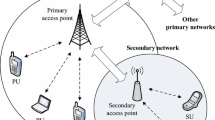Abstract
The problem of resource allocation in a spectrum leasing scenario in cooperative cognitive radio networks is addressed. The system model consists of a number of primary user (PU) pairs and a secondary user (SU) pair. The SU pair allocates the whole its transmission power in a portion of transmission frame to relay the primary signals. In return, the PU pairs lease their unused portion of transmission frame to the SU pair. In this way, the PU pairs take advantage of their unused portion of time to gain savings in their transmission power. However, a few important questions must be answered: When to lease and how much to be leased. We determine when is beneficial for PUs to lease their unused spectrum portion to the SU and how much of PUs’ resources is optimum to be leased. An efficient auction mechanism is proposed and the existence and uniqueness of the Nash Equilibrium (NE) for the proposed auction game is proved. Since the NE is the solution of a set of fixed point problems, two iterative algorithms, synchronous and asynchronous schemes, are proposed to reach the NE in an iterative manner and their convergence to the fixed point is also proved. Finally, the proposed auction is extended to a network with multiple secondary user pairs. Simulation results acknowledge the more efficient utilization of resources as a result of implementing the proposed auction based resource allocation.







Similar content being viewed by others
Notes
Zero Mean Circularly Symmetric Complex Gaussian
References
Hakim, K., Jayaweera, S. K., El-howayek, G., & Mosquera, C. (2010). Efficient dynamic spectrum sharing in cognitive radio networks: Centralized Dynamic Spectrum Leasing (C-DSL). IEEE Transactions on Wireless Communications, 9(9), 2956–2967.
Jayaweera, S. K., & Li, T. (2009). Dynamic spectrum leasing in cognitive radio networks via primary-secondary user power control games. IEEE Transactions on Wireless Communications, 8(6), 3300–3310.
Stanojev, I., Simeone, O., Bar-Ness, Y., & Yu, T. (2008). Spectrum leasing to cooperating secondary ad hoc networks. IEEE Journal on Selected Areas in Communications, 26(1), 203–213.
Wang, X., Li, Z., Xu, P., Xu, Y., Gao, X., & Chen, H. H. (2010). Spectrum sharing in cognitive radio networks an auction based approach. IEEE Transactions on Systems, Man and Cybernetics, Part B: Cybernetics, 40(3), 587–596.
Gao, L., Xu, Y., & Wang, X. (2011). MAP: Multiauctioneer progressive auction for dynamic spectrum access. IEEE Transactions on Mobile Computing, 10(8), 1144–1161.
Jayaweera, S. K., Bkassiny, M., & Avery, K. A. (2011). Asymmetric cooperative communications based spectrum leasing via auctions in cognitive radio networks. IEEE Transactions on Wireless Communications, 10(8), 2716–2724.
Lim, H. J., Seol, D. Y., & Im, G. H. (2011). Power Budget allocations for Auctions with Multi-Bands in Cooperation-Based Spectrum Leasing. In Proc. IEEE int. conf. on commun. (ICC), pp. 1–6.
Wu, Y., Wang, B., Liu, K. J. R., & Clancy, T. C. (2008). Collusion-resistant multi-winner spectrum auction for cognitive radio networks. In Proc. IEEE GLOBECOM, pp. 1–5.
Stanojev, I., Simeone, O., Spagnolini, U., Bar-Ness, Y., & Pickholtz, R. L. (2009). An auction-based incentive mechanism for non-altruistic cooperative ARQ via spectrum-leasing. In Proc. IEEE GLOBECOM, pp. 1–6.
Toroujeni, S. M. M., Sadough, S. M., & Ghorashi, S. A. (2011). An auction-based approach for spectrum leasing in cognitive radio networks. In Proc. wireless advanced (WiAd), pp. 106–109.
Zhang, Y., Niyato, D., Wang, P., & Hossain, E. (2012). Auction-based resource allocation in cognitive radio systems. IEEE Communications Magazine, 50(11), 108–120.
Krishna, V. (2002). Auction theory. London, UK: Academic Press.
Horn, R. A., & Johnson, C. R. (1985). Matrix analysis. Cambridge, UK: Cambridge University Press.
Bertsekas, D. P., & Tsitsiklis, J. N. (1989). Parallel and distributed computation: Numerical methods (2nd edn.). Athena Scientific.
Hageman, L., & Young, D. (1981). Applied iterative methods. New York: Academic.
Mwangoka, J., Letaief, K., & Cao, Z. (2009). Joint power control and spectrum allocation for cognitive radio networks via pricing. Physical Communication, 2(1–2), 103–115.
Yates, R. (1995). A framework for uplink power control in cellular radio systems. IEEE Journal on Selected Areas in Communications, 13(7), 1341–1348.
Acknowledgments
This work is supported in part by ITRC (Iranian Telecommunications Research Center).
Author information
Authors and Affiliations
Corresponding author
Appendices
Appendix 1: Proof of Proposition 1
We need to set the derivative of the utility to zero:
At last, the optimum value of the cooperative transmission power of the SU for PU i, \({\bar P_{ST,i}}\), can be calculated as given in (20), (21) and (22) and therefore the maximum utility of the i-th PU, as a result of cooperation with SU, can be written as in Eq. (19) and the proposition is proved.
Appendix 2: Proof of Proposition 2
Assume that \(\left[ {\beta_i^{(2)},\beta_i^{(1)}} \right]\) is not strictly decreasing with \(\beta \in \left[ {\beta_i^{(2)},\beta_i^{(1)}} \right]\). Then there must exist a β 1 < β 2, such that \({f_i}\left( {{\beta_1}} \right) < {f_i}\left( {{\beta_2}} \right)\), i.e. \({U_i}\left( {P_{ST,i}^*\left( {{\beta_1}} \right),{\beta_1}} \right) \leq {U_i}\left( {P_{ST,i}^*\left( {{\beta_2}} \right),{\beta_2}} \right)\). However, optimality of \({\bar P_{ST,i}}(\beta)\) results in \({U_i}\left( {P_{ST,i}^*\left( {{\beta_1}} \right),{\beta_1}} \right) \geq {U_i}\left( {P_{ST,i}^*\left( {{\beta_2}} \right),{\beta_2}} \right)\) and we have arrived to a contradiction, which verifies that f i (β) is strictly decreasing with \(\beta \in \left[ {\beta_i^{(2)},\beta_i^{(1)}} \right]\).
Appendix 3: Proof of Proposition 3
The best bid of PU i, b * i , can be calculated according to the following:
Thus, b * i can be written as
Recall that f i (β) is strictly increasing over \(\left( {0,\beta_i^{(1)}} \right)\), with \({f_i}\left( {\beta_i^{(1)}} \right) < 0\). Thus, using a search method (like bisection method) it is possible to find a transmission frame portion \({\bar \beta_i} \in \left({0,\beta_i^{(1)}}\right)\), such that \({f_i}\left({{{\bar \beta }_i}} \right)=0\). Then for any transmission frame portion \(\beta > {\bar \beta_i}\), we have U max i < 0, which implies that b * i = 0, and the proposition is proved.
Rights and permissions
About this article
Cite this article
Adian, M.G., Aghaeinia, H. An auction-based approach for spectrum leasing in cooperative cognitive radio networks: when to lease and how much to be leased. Wireless Netw 20, 411–422 (2014). https://doi.org/10.1007/s11276-013-0612-y
Published:
Issue Date:
DOI: https://doi.org/10.1007/s11276-013-0612-y




